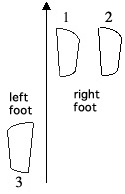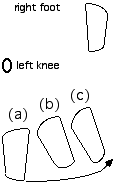THE SOUND OF THE FOOT IN SEIZA ACTION
There are two different types. One is to make a noise and the other is to
step forward without a sound. Both have their reasons, but the silent footwork
was the original one, so as not to attract the opponent’s attention. From a
training point of view it is difficult to use the sliding footwork and gain
good results. In fact some schools are teaching people to deliberately make
a stamping sound in Seiza techniques. This way it is physically easier for beginners
to learn Ki-ken-tai-ichi.
Regardless of other people Master Oh-e told us to make a sound for Seiza techniques.
When students reached the Oku Iai stage he taught silent footwork. I can clearly
recall many senior high graded Iaidoka intentionally stamping in Kochi 30 or
40 years ago. My teacher Yamamoto Takuji Sensei used to tell me, Stamp the foot as strong as the floor boards are in the hall. Making
a sound seems to be powerful, on the other hand silent footwork is graceful.
Both ways are correct. It is for the individual to choose depending on ones
experience and technical ability. ∆ Direction of extending the front foot: The
placement of the right foot on Nukitsuke is of major importance. Some practitioners
step widely to the forward right to keep the body balanced and steady.
 |
Stepping as in 1 is adequate. Position 2 is too wide from
the centreline, even if it looks steady it does not target Kirioroshi.
Moving the foot directly forward, one can lose balance. On the other
hand, if it is too wide a step the target will be missed in Kirioroshi.
Adequate footwork should be acquired as a result of experimentation.
THE IMPORTANCE OF FOOTWORK
In Iaido, Ashi (feet), Koshi (hips) and Chikara (power) are too be treated
as the essence, especially the feet. As the lowest part of the body they
produce the energy to attack. To find the right foot position is important
to achieve correct posture and attack with intensity. |
NUKITSUKE AND TWISTING THE HIPS
When employing a single handed cut or thrust in Iaido, hip twist is required
to get full results. Without a counter hip twist one cannot produce enough power
for single handed techniques. It is the same in Nukitsuke. Keep the body square
until the Kissaki leaves the Koikuchi. Then twist the hip as Nukitsuke action
is taken. Although the degree of the twist does differ between Shimomura Ha
and Tanimura Ha. Connecting the body twist with the knee and foot position:
When Nukitsuke action is taken twisting the hips, the body faces slightly to
the left.
 |
To hold the body weight on the left knee, the left foot moves to the
right to keep the body balanced. How far one moves this foot is a personal
choice. However, if it is moved over too much. It is uncomfortable in
keeping the body square.
Oe Sensei’s direct student Mori Shigeki Sensei has explained about
the Hanmi posture at Nukitsuke. The hips are kept
square at Nukitsuke. However drawing the sword inevitably turns the body
into Hanmi. Except twisting the hip at the same time closely resembles
the Shimomura Ha technique.
COMBINATION OF FOOTWORK AND THE BODY TWIST
Stamping with the right foot or sliding it smoothly forward will make
a substantial difference in the body twisting action. |
 Taking action facing the opponent
square on with Ki-ken-tai-ichi and stamping is not so difficult. But it is not
so easy twisting the body at the same time.
Taking action facing the opponent
square on with Ki-ken-tai-ichi and stamping is not so difficult. But it is not
so easy twisting the body at the same time.
 In comparison, Nukitsuke with
silent, smooth footwork, it is easier to control forward movement and twisting
the body. The first one is useful for practising Ki-ken-tai-ichi and the second
for flexible body twisting exercise. To make a stamping sound or not is a personal
choice, therefore outsiders have no right to criticise this point. The stamping
technique could be beneficial for beginners in learning timing.
In comparison, Nukitsuke with
silent, smooth footwork, it is easier to control forward movement and twisting
the body. The first one is useful for practising Ki-ken-tai-ichi and the second
for flexible body twisting exercise. To make a stamping sound or not is a personal
choice, therefore outsiders have no right to criticise this point. The stamping
technique could be beneficial for beginners in learning timing.
 |
Page 8 |

